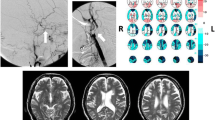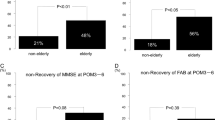Abstract
Background
The mechanisms underlying post-extracranial to intracranial (EC-IC) bypass neurocognitive changes are poorly understood.
Methods
Data from 55 patients who underwent a unilateral EC-IC bypass for atherosclerotic internal carotid artery (ICA)/middle cerebral artery (MCA) steno-occlusive disease were retrospectively evaluated. These patients underwent neuropsychological examinations (NPEs), including assessment by the Wechsler Adult Intelligence Scale-Third Edition and Wechsler Memory Scale-Revised (WMS-R) before and 6 months after EC-IC bypass. Results of NPEs were converted into Z-scores from which preoperative cognitive composite scores (CSpre) and postoperative cognitive composite scores (CSpost) were obtained. The association between the change of composite score between pre- and postoperative NPEs (CSpost-pre = CS post – CS pre) and various variables were assessed. These latter variables included occluded artery (ICA or MCA), preexisting ischemic lesion as verified in preoperative T2WI, robust bypass patency as verified by MRA performed approximately 6 months postoperatively, and postoperative transient neurological symptoms and/or postoperative chronic subdural hematoma (CSDH), both of which were dichotomized as postoperative events.
Results
Postoperative MRI follow-up (median, 6 months; interquartile range, 5–8 months) confirmed successful bypasses in all patients, with no additional ischemic lesions on T2WI when compared with preoperative imaging. Further, MRA showed patent bypasses in all patients. A nearly statistically significant CS post-pre decrease was observed in patients with postoperative events when compared with those without postoperative events (−0.158 vs. 0.039; p = 0.069). A multiple regression model predicting CSpost-pre was performed. After controlling for occluded arteries, postoperative events were identified as an independent predictor of a decline in CSpost-pre (p = 0.044). In the group rate analysis, three of four postoperative NPE scores (Performance IQ, WMS-memory, WMS-attention) were significantly improved relative to preoperative NPE scores.
Conclusions
Postoperative transient neurological symptoms and/or CSDH might play a significant role in the subtle decline in cognition following an EC-IC bypass. However, this detrimental effect was small, and based on the group rate analysis, we concluded that a successful unilateral EC-IC bypass does not adversely affect postoperative cognitive function.





Similar content being viewed by others
Abbreviations
- CBF:
-
cerebral blood flow
- CSDH:
-
chronic subdural hematoma
- DSA:
-
digital subtraction angiography
- DWI:
-
diffusion-weighted imaging
- EC-IC:
-
extracranial to intracranial
- ICA:
-
internal carotid artery
- MCA:
-
middle cerebral artery
- MRA:
-
magnetic resonance angiography
- NPE:
-
neuropsychological examination
- OA:
-
occipital artery
- PIQ:
-
performance IQ
- SPECT:
-
single-photon emission computed tomography
- STA:
-
superficial temporal artery
- T2WI:
-
T2-weighted image
- VIQ:
-
verbal IQ
- WAIS-III:
-
Wechsler Adult Intelligence Scale-Third Edition
- WMS-attention:
-
attention/concentration score in WMS-R
- WMS-memory:
-
composite memory score in WMS-R
- WMS-R:
-
Wechsler Memory Scale-Revised
References
Amin-Hanjani S, Barker FG II, Charbel FT, Connolly ES Jr, Morcos JJ, Thompson BG (2012) Extracranial-intracranial bypass for stroke. Is this the end of the line or a bump in the road? Neurosurgery 71:557–561
Andoh T, Sakai N, Yamada H, Yano H, Hirayama H, Imao Y, Deguchi K (1992) Chronic subdural hematoma following bypass surgery—report of three cases. Neurol Med Chir (Tokyo) 32:684–689
Dong Y, Teoh HL, Chan BP, Ning C, Yeo TT, Sinha AK, Venketasubramanian N, Slavin MJ, Sachdev P, Collinson SL, Chen C, Sharma VK (2012) Changes in cerebral hemodynamics and cognitive parameters after external carotid-internal carotid bypass surgery in patients with severe steno-occlusive diseases: a pilot study. J Neurol Sci 322:112–116
Fiedler J, Přbāň V, Škoda O, Schenk I, Schenková S, Poláková S (2011) Cognitive outcome after EC-IC bypass surgery in hemodynamic cerebral ischemia. Acta Neurochir 153:1303–1312
Fierstra J, MacLean DB, Fisher JA, Han JS, Mandell DM, Conklin J, Poublanc J, Crawley AP, Regli L, Mikulis DJ, Tymianski M (2011) Surgical revascularization reverses cerebral cortical thinning in patients with severe cerbrovascular steno-occlusive disease. Stroke 42:1631–1637
Fujita K, Maekawa H, Dairoku H, Yamanaka K (2006) [Japanese Wechsler Adult Intelligence Scale-Third edition.] Tokyo:Nihon Bunka Kagakusha, (Jpn)
Grubb RL Jr, Powers WJ, Clarke WR, Videen TO, Adams HP Jr, Derdeyn CP (2013) Surgical results of the carotid occlusion surgery study. J Neurosurg 118:25–33
Hirooka R, Ogasawara K, Inoue T, Fujiwara S, Sasaki M, Chida K, Ishigaki D, Kobayashi M, Nishimoto H, Otawara Y, Tsushima E, Ogawa A (2009) Simple assessment of cerebral hemodynamics using single-slab 3D time-of-flight MR angiography in patients with cervical internal carotid artery steno-occlusive diseases: comparison with quantitative perfusion single-photon emission CT. AJNR 30:559–563
Inoue T, Ohwaki K, Tamura A, Tsutsumi K, Saito I, Saito N (2013) Subclinical ischemia verified by somatosensory evoked potential amplitude reduction during carotid endarterectomy: negative effect on cognitive performance. J Neurosurg 118:1023–1029
Inoue T, Ohwaki K, Tamura A, Tsutsumi K, Saito I, Saito N (2014) Subtle structural change demonstrated on T2-weighted images after clipping of unruptured intracranial aneurysm: negative effect on cognitive performance. J Neurosurg 120:937–944
Inoue T, Tsutsumi K, Adachi S, Tanaka S, Saito K, Kunii N (2006) Effectiveness of suturing training with 10–0 nylon under fixed and maximum magnification (x20) using desk type microscope. Surg Neurol 66:183–187
JET Study Group. Japanese EC-IC bypass trial (JET study) (2002) The second interim analysis. Surg Cereb Stroke (Jpn) 30:434–437
Marshall RS, Festa JR, Cheung YK, Pavol MA, Derdeyn CP, Clarke WR, Videen TO, Grubb RL, Slane K, Powers WJ, Lazar RM (2014) Randomized evaluation of the Carotid Occlusion and Neurocognition (RECON) trial. Main result. Neurology 82:744–751
Powers WJ, Clarke WR, Grubb RL Jr, Videen TO, Adams HP Jr, Derdeyn CP (2001) Extracranial-intracranial bypass surgery for stroke prevention in hemodynamic cerebral ischemia: the Carotid Occlusion Surgery study randomized trial. JAMA 306:1983–1992
Reynolds M, Grubb RL Jr, Clarke WR, Powers WJ, Zipfel GJ, Adams HP Jr, Derdeyn CP (2013) Investigating the mechanisms of perioperative ischemic stroke in the carotid occlusion surgery study. J Neurosurg 119:988–995
Sasoh M, Ogasawara K, Kuroda K, Okuguchi T, Terasaki K, Yamadate K, Ogawa A (2003) Effect of EC-IC bypass surgery on cognitive impairment in patients with hemodynamic cerebral ischemia. Surg Neurol 59:455–463
Schmiedek P, Piepgras A, Leinsinger G, Kirsch CM, Einhäupl K (1994) Improvement of cerebrovascular reserve capacity by EC-IC arterial bypass surgery in patients with ICA occlusion and hemodynamic cerebral ischemia. J Neurosurg 81:236–244
Sugishita M (2001) [Japanese Wechsler Memory Scale-Revised] Tokyo:Nihon Bunka Kagakusha (Jpn)
Yamaguchi K, Kawamata T, Kawashima A, Hori T, Okada Y (2010) Incidence and predictive factors of cerebral hyperperfusion after extracranial-intracranial bypass for cerebrovascular diseases. Neurosurgery 67:1548–1554
Author information
Authors and Affiliations
Corresponding author
Ethics declarations
Conflicts of interest
All authors certify that they have NO affiliations with or involvement in any organization or entity with any financial interest or non-financial interest in the subject matter or materials discussed in this manuscript.
Electronic supplementary material
Below is the link to the electronic supplementary material.
Video 1
Intraoperative video showing left STA-MCA double anastomosis for a 53-year-old female with left MCA occlusion. (MP4 32651 kb)
Rights and permissions
About this article
Cite this article
Inoue, T., Ohwaki, K., Tamura, A. et al. Postoperative transient neurological symptoms and chronic subdural hematoma after extracranial-intracranial bypass for internal carotid/middle cerebral atherosclerotic steno-occlusive diseases: negative effect on cognitive performance. Acta Neurochir 158, 207–216 (2016). https://doi.org/10.1007/s00701-015-2620-4
Received:
Accepted:
Published:
Issue Date:
DOI: https://doi.org/10.1007/s00701-015-2620-4




